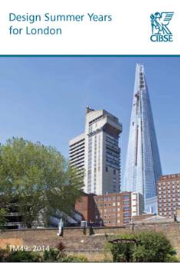It is evident that the world is facing an increase in extreme weather events affecting people’s health and wellbeing and cities will experience more intense and frequent summer hot events exacerbated by the UHI effect. Anastasia Mylona, CIBSE Environmental Data Coordinator, explains: “The UHI effect is a result of dense built up urban centres and the lack of green areas and manifests as a temperature difference between the urban centres and their rural surroundings. ‘TM49: Design Summer Years for London’ and the accompanied datasets for building thermal simulation, introduce the concept of incorporating the UHI effect and the severity of hot events in the design of buildings. Specifically, instead of having a single Design Summer Year (DSY) for London (using observed data from Heathrow) three DSYs are now available capturing the local climate in three different London locations (urban, semi-urban, and rural) and for three years of varying severity of hot events.”
‘TM49: Design Summer Years for London’, is the latest addition to the Chartered Institution of Building Services Engineers’ (CIBSE) range of guidance.
The free of charge guidance will inform building design and adaptation strategies to better cope with the very real threat of climate change. CIBSE is offering this guide on its online Knowledge Portal and in print to advise particularly on designing buildings in London which have the potential to perform well in Urban Heat Islands (UHI) and contribute to adapting the city for the future.
It is evident that the world is facing an increase in extreme weather events affecting people’s health and wellbeing and cities will experience more intense and frequent summer hot events exacerbated by the UHI effect. Anastasia Mylona, CIBSE Environmental Data Coordinator, explains: “The UHI effect is a result of dense built up urban centres and the lack of green areas and manifests as a temperature difference between the urban centres and their rural surroundings. ‘TM49: Design Summer Years for London’ and the accompanied datasets for building thermal simulation, introduce the concept of incorporating the UHI effect and the severity of hot events in the design of buildings. Specifically, instead of having a single Design Summer Year (DSY) for London (using observed data from Heathrow) three DSYs are now available capturing the local climate in three different London locations (urban, semi-urban, and rural) and for three years of varying severity of hot events.”
The newly published TM49 also enables designers to analyse the summer performance of their buildings under future conditions. CIBSE advocates passive design using the fabric and characteristics of the building to interact with the external environment to enhance occupants’ internal thermal comfort conditions. This minimises, or may even eliminate, the use of mechanical systems, further improving building performance even in dense urban environments with observed UHI.
CIBSE has invested in a series of resources which aim to assist building professionals in considering weather and climate change in the design and running of their buildings. These include ‘Probabilistic Climate Profiles’ (ProClips), ‘Design for Future Climate – Case Studies’, ‘TM55: Design for Climate Change’ and ‘TM52: The Limits of Thermal Comfort – Avoiding Overheating in European Buildings’.
‘Design for Future Climate – Case Studies’ presents current practice and understanding of carrying out building adaptation strategies, rather than commenting on best practice. CIBSE asked five of 48 projects funded by the Technology Strategy Board to reflect on their experience in dealing with climate uncertainty, large volumes of weather datasets and communicating climate related risks to their clients. These were part of the ‘Design for Future Climate’ programme to build a body of evidence of the commercial advantages of considering future climate adaptation in current building projects, both new build and refurbishment.
This wealth of information exemplifies CIBSE’s key role in providing guidance on the impact of future climate on building designs. It is imperative that future climate change is considered to create better places to live and work and improve building performance. Guidance is available by visiting the CIBSE Knowledge Portal and is free to CIBSE members.